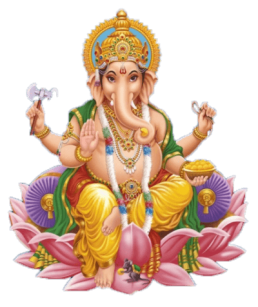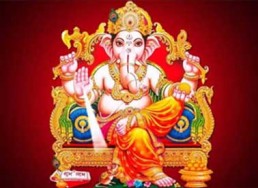Mooshika Vahana
चामरकर्ण विलम्बितसूत्र ।
वामनरूप महेस्वरपुत्र
विघ्नविनायक पाद नमस्ते ॥
cāmarakarṇa vilambitasūtra .
vāmanarūpa mahesvaraputra
vighnavināyaka pāda namaste ..

Description
Sri Swami Chinmayananda describes the symbolism of Lord Ganesha as follows:
The Lord of Obstacles, Sri Vighneswara has four arms representing the four inner equipments, the Anthahakarana(Mind, Intellect, Memory and Ego).
In one hand He has the ROPE and in the other He has an AXE. On the spiritual pilgrimage, all obstacles are created by the very subjective and objective worlds in the seeker himself. Sri
Vighneswara chops them off with the AXE. He cuts off the attachments of His devotees to the world of plurality and thus ends all the consequent sorrows. He holds the attention of the seeker constantly towards the Higher, and pulls us nearer and nearer to the Truth and ultimately ties him down to the Highest Goal with the ROPE. With one hand, He blesses all His devotees and protects (ABHAYA) them from all obstacles on their spiritual path of seeking the Supreme, and with the other hand He feeds the seeker with MODAKA, representing the reward of the joys of sadhana — the “Joy of Experiencing the Reality”.
The meaning of this Shloka
Key Phrase: विघ्न विनायक पाद नमस्ते (Vigna Vinayaka Pada Namasthe)
नम: + ते – Salutations to thee
विनायक – विश्वस्य – All the universe (everything that IS)
नायक:- one who is Lord of
So, this phrase means – Salutations to thee who has conquered (is the Lord of) everything including challenges.
Who is that?
वामन रूप – One who is short in stature – someone who keeps his/her ego small, is humble
महेश्वर पुत्र – One who has recognized that he/she is child of Maheshwara
महेश्वर – the Supreme Being or Parabrahmam
As each of us is a child of the universal God, it applies to each one of us. We need to recognize and realize it. The confidence this recognition builds inside is amazing.
चामर कर्ण – Fan-like ears.
One who listens, takes in a lot more, understands a lot more about what’s going on around.
विलम्बित सूत्र – सूत्र is truth/aphorism. विलम्बित is that which is connected.
When you understand all the connected truths or in other words aligned with Dharma (truths)
मोदक हस्त – One who has sweet on hand is also the one who gives it – attribute it as someone whose very presence is enjoyable.
मूषिक वाहन – One who has a mouse as mount. The mouse is never still, it keeps running around. The mind is like a mouse, constantly flitting. Therefore He is the one who has the mind totally under his control – an attribute we all should pray and strive for.
In summary, if one can control one’s mind, be nice in nature, listen carefully, be aligned to Dharma, keep the ego small, realize that one is the child of the Supreme Being, then, as a master of all including challenges, Salutations to Thee, Lord Vinayaka.
Other Ganesha Shlokams
Agajanana Padmakam
We meditate day and night on the one-tusked one who is the sun for the lotus in the form of the face of Pārvatī, the one with the elephant face and the one who is the giver of all desired ends to his
Gajananam Bhuta
I bow to you, the Lord with the face of an elephant (Gajanana), one who is served by the celestial attendants (Bhoota ganas) and other beings. The one who consumes the extract of Kapitha (wood apple)
Gananamtva Ganapatim
Among the celestial attendants (Ganas), you are the Lord (Ganapathi), We offer sacrificial oblations to you You are the wisest among the scholars. Your wisdom is known to be highest quality and uncomp
Ganapathi Atharvashirsha
The Ganapati Atharvasirsha Upanishad is a Sanskrit text and a minor Upanishad of Hinduism. It is a late Upanishadic text dedicated to Ganesha, the deity representing intellect.
Ganapati Stotram
As the rays from the lotus-face of Gauri (Devi Parvati) is always on her beloved son Gajanana (Who has the face of an Elephant), Similarly, the grace of Sri Ganesha is always on his devotees; Granting
Ganesh Chathurthi
Significance of Ganesh Puja, Vinayaka Chavithi or Chathurthi. See how to prepare for Ganesha Pooja, How to perform the Puja with Video instructions and enjoy Audio devotional songs, uninterrupted and without ads.
Ganesha Gayatri Mantra
We pray to the one-tusked; we meditate on the one having a twisted trunk. May that Ganapati (one-tusked) inspire us (to meditate).
Ganesha Pancharathnam
The composer, Guru Sri Adi Shankaracharya had praised the God Ganesha by presenting these five stanzas as five jewels, hence the name Maha Ganesha Pancharatnam.
Ganesha Stavah
Ganesha Stavah or Ganapati Stavah is a set of 13 verses that describe the glory of Lord Ganesha. Gaṇapati stavaḥ is said to be from Ganesh Purana - upāsanā khaṇḍa adhyāya 13.
Sankata Nashana Ganesha Stotram
This stotram is from Narada Purana. Sankata means problems, difficulties and Nashanam means to destroy. So, by chanting this stotram one is praying to Lord Ganesha to remove his difficulties. In Sanskrit, English Translation, Meaning, Significance…
Shuklambaradharam
I meditate upon (Lord Ganesa), the one who wears a white garment, who is all-pervasive, who has a (bright) complexion like the moon, who has four hands, who has a cheerful face, for the removal of all
Vakratunda Mahakaya
O god with the twisted trunk, broad-bodied, brilliant as thousand suns, bless me with freedom from obstructions and hindrances in all my works and for all times.
Mooshika Vahana – Ganesha – In Sanskrit with English Transliteration, Translation and Meaning. Commentary for selected Shlokams.


